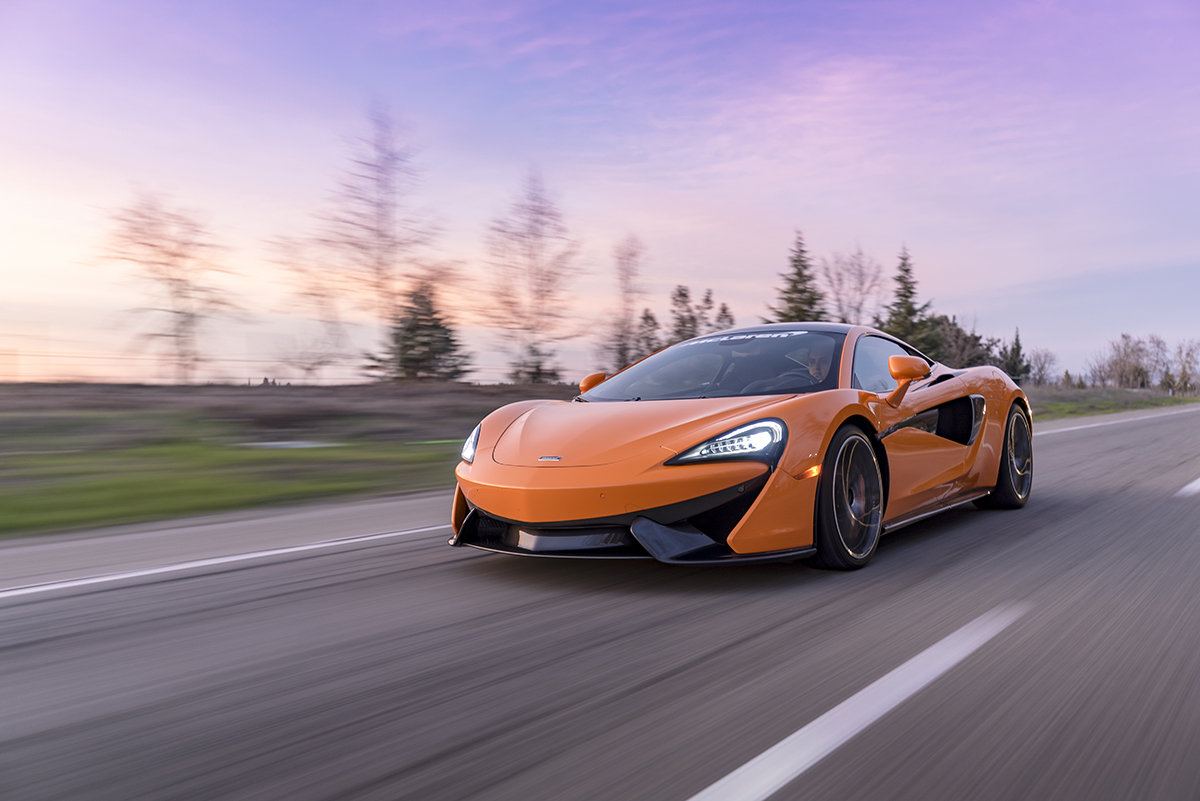Four-Cylinder Photos in Fresno
Justin Keys uses his Tamron SP 24-70mm VC and SP 15-30mm VC wide-angle lenses to capture the sexiest, sportiest automobiles in Northern California.
More Photo Tips | Video Gallery | Photo Gallery | Enewsletter sign-up
By Jenn Gidman
Images By Justin Keys
One of Justin Keys' first photo assignments was an unexpected one: taking photos for the local mayor's office when then-California Gov. Arnold Schwarzenegger came for a visit. "They paid me $500, I got to meet Arnold—it was amazing," he says.
Since that 2006 photo shoot, the Fresno-based photographer has dabbled in everything from weddings and other event photography to real estate documentation, but that all changed with a chance encounter at a neighborhood Shell station. "I spotted this Ferrari 458 Italia, black on black, a really sweet-looking car," Justin says. "I asked the guy who was driving it if I could take some photos, and he agreed."
That moment spurred Justin to practice his picture-taking at classic-car gatherings, and his hobby soon became a career when he wandered into a Fresno dealership for CJ Wilson Automotive Group in September 2017. "I was an equipment salesman at the time, and I was trying to sell some gear to them," he says. "I asked if I could take pictures of some of the cars, and they had me come back to shoot an Audi experience event. The event happened to be on my wife's birthday, but I figured it was worth the risk, and she forgave me."
That initial "job interview" led to a full-time gig with CJ Wilson, where Justin now spends his days capturing BMWs, Audis, and Porsches and trying to figure out how to show off each car's uniqueness from behind the lens. "Every car is different—they're like people," he says. "Before I start photographing a car, I check it inside and out, studying the lines, noticing distinct details, so I can most accurately portray that car's personality."
Justin's two main lenses for his automotive photography are the Tamron SP 24-70mm VC (he's also tried out the G2 version) and SP 15-30mm VC wide-angle lenses. "The 24-70 is my workhorse," he says. "I use it every day, all day long. The 24-70 is flexible for when I have to get into tight corners in a showroom or photograph the interior of a car. When I'm shooting car exteriors, shooting at the 70mm end looks best, because I want to compress the background to get better depth-of-field and separate the background from the body of the car so it looks as 3D as possible. The G2, which I recently got to test-drive, is like a diamond in terms of what it does to enhance the clarity and color, which is crucial for car photography."
The 15-30 is Justin's go-to lens when he's taking a "rolling shot," or "roller." "This is where you're chasing another vehicle on the road and trying to get as wide a shot as you can to make the car look as large as possible, all while still getting some background in," he explains. "The 15-30 offers that versatility. Plus I use that lens often for other types of photography, including landscapes and even portraits for a unique look."
How Justin composes his car photos, and what angle he captures the cars from, depends on what he's trying to showcase. "I have three basic perspectives I have as a baseline: at 'eye' level' (straight on), going down a little lower so I have to shoot up at the car, and going a little higher so I have to shoot down at it," he says. "I'll ask myself: Which is the cleanest look for each car? What story does each perspective tell?"
For more artistic photos, Justin is trying to capture a car's personality. "Just like people, cars have attitudes," he explains. "And capturing that attitude comes down to, again, finding the best angle to emphasize it. If I want to make an SUV look more intimidating or rugged, for example, I'll typically squat down so I can shoot up at it and make it look larger than life. For a sports car, I'll usually want to make it look sexier, so I'll do what's called a 'cheesecake' shot, with the car turned at an angle for a three-quarter photo."
That attitude is what Justin was trying to capture when he photographed a McLaren 570S with its doors aloft like wings. "We took this photo outdoors in January, and there were a bunch of birds milling around during our session," he says. "That's where we got the idea to put the doors up like the car was about to fly away. I especially wanted to capture those wispy clouds, and to show off the color contrast between the car and the blue sky."
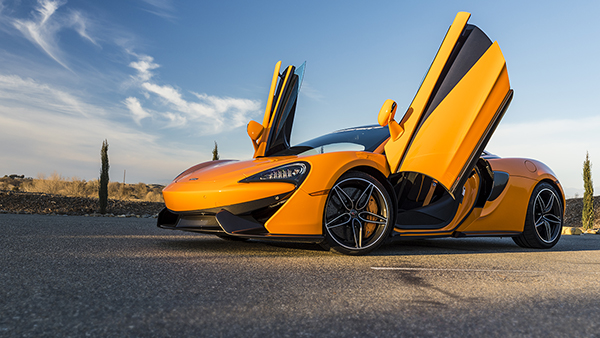
24-70mm (35mm), F/7.1, 1/160th sec., ISO 320
Click image to view larger
For inventory photography, Justin needs to not only show the vehicle in its entirety, but also capture all of the gadgets, buttons, and gizmos that soup it up. "When a potential customer is checking out the photos, they'll want to know about every option the vehicle has to offer," he says. "I actually love looking for aspects of the car that pop out."
Using the 24-70 to get detail shots in tight quarters, like the one shown here of a gearshift for a McLaren 675LT, is one of Justin's favorite parts of the job. "I don't typically get to cruise around in the cars at my dealership, but I have to move them around the lots so I can photograph them, so I do get the opportunity to sit inside them and check out the interiors," Justin says. "I'm always thinking of the thought process that went behind every feature, like the steering wheel or the look of the display. What was the designer or engineer looking to do? That's what I did here with this gearshift, which I captured through the side vent on the engine bay."
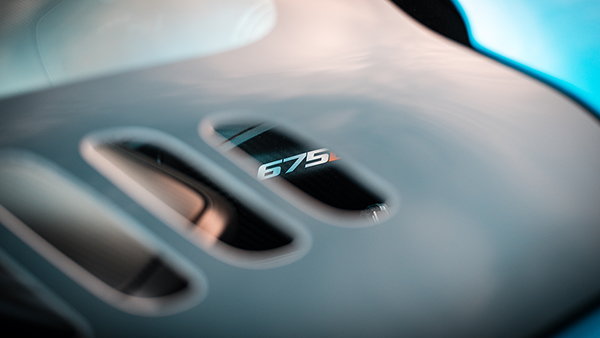
24-70mm (50mm), F/2.8, 1/250th, ISO 200
Click image to view larger
Justin typically photographs in broad daylight, usually on the outdoor lots of his dealership. "I don't like doing inventory photography, which is what consumers see on our website, in the so-called golden hour or blue hour," he says. "The light is a little more orangey than I'd like it to be. I prefer to shoot from 8:30 or 9 in the morning till about 4 or 5 in the afternoon. If I'm shooting a photo to be more artistic, however, like for Instagram, I'll take the photo outside in golden light with a clean or environmental background."
Some cars are more photogenic than others. "Anything metallic-colored does well in outdoor light," Justin says. "Black cars and white cars can be challenging, however. Black cars are the hardest to shoot because of the way light reflects off of them. I use a circular polarizing lens, or CPL, because that helps me knock down any reflections that pass across the body of the vehicle. I'm also planning on investing in a variable neutral-density filter, which will come in especially handy when I'm shooting white cars against white backgrounds."
For his nighttime or indoor shots, Justin either lights the car with a strobe from one particular angle, or he'll shoot several different exposures, lighting different parts of the vehicle so he can then create a composite. The latter approach is what Justin took when photographing a red Ford Mustang GT in front of a bridge in downtown Fresno, a popular site for automotive photographers. "I did separate exposures for the hood, the headlights, the rims, the puddle, and the background, then brought them all together," he says. "It felt like I was doing a fine oil painting—I kept going back in to add to it until I came out with this final image."
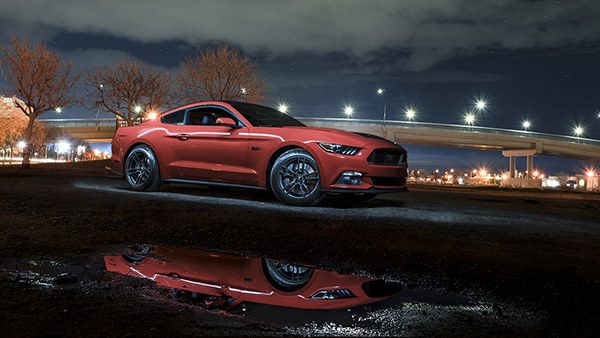
24-70mm (35mm), F/8, 25 sec., ISO 50
Click image to view larger
Justin used a similar technique for an orange Porsche he photographed indoors. "The lead guitarist for a really famous rock band owns that vehicle," he says. "It's a $600,000 car. The white vehicle you see to the left of it is a Porsche 911 R, which CJ Wilson owns; that's an $800,000 car. And the red car is a Porsche 918, a $2 million car. I always liked muscle cars better than foreign, exotic cars until recently, because now it's part of my job. I didn't realize these cars were worth that much!"
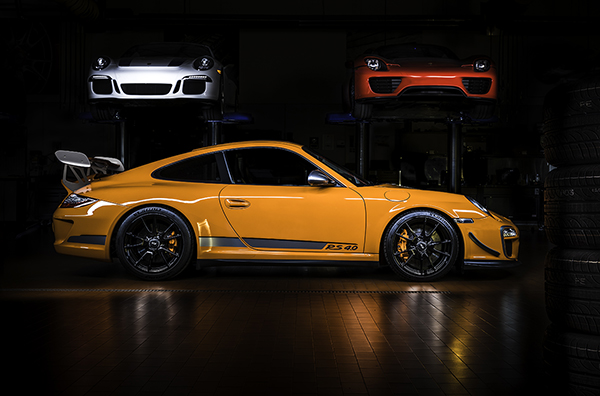
24-70mm (50mm), F/13, 20 sec., ISO 50
Click image to view larger
Because he wanted to light each specific section of the image, Justin shot this photo on a tripod and dove into some light-painting. "I went to Best Buy and bought a $150 house-brand LED light that's meant for shooting video on top of a DSLR and turned it up to 5600 Kelvin," he says. "This single image you see is composited from 12 or 15 separate images: I have an image of just the rims, each individual car behind the orange Porsche, and so on."
When he's not on location, Justin has two specific areas at his workplace that he uses for his backgrounds. "At the BMW dealership, there's a line of green hedges between the two lots, so that's where I usually position the cars, though I have to work around trash receptacles and UPS trucks coming in all the time," he says. "For the Audis and Porsches, which I usually want to make look a little artsier, we have an upstairs deck that lends itself well to a photo shoot. There's an aluminum overhang and the walls are white, so it's almost like I have built-in reflectors all around the 'set.'"
Sometimes he explores the local neighborhood for background ideas. "We have a volcano-red McLaren 650S, aka the 'Spider,' here on consignment," Justin says. "It's a quarter-million-dollar car. Right behind our dealership, there's a small business district that features a lot of old buildings. This one white building we found had a faded, worn look, that along with the weeds and dirt driveway made for a nice contrast with the sleekness of the red car."
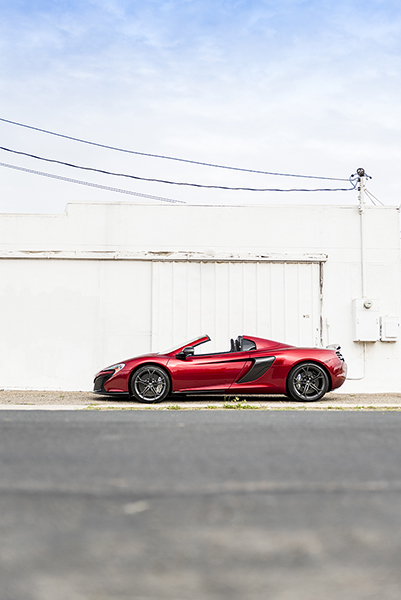
24-70mm (46mm), F/2.8, 1/320th sec., ISO 160
Click image to view larger
As for the rolling shots he mentioned earlier, he stresses that safety is the number-one concern. "You're not putting your life at risk necessarily, but you are leaning out the window, going 65 mph or 70 mph down a two-lane road," Justin says. "This photo you see here of a McLaren 570S was taken just around sunset. My camera was set at 1/60th sec., and I was shooting in burst mode. I was leaning out of the car, trying to get as low as I could to the ground to get the best angle. We were going so fast that the sticker on the mode selector dial flew off, then the selector itself broke. I had to bring the camera to get serviced afterward."
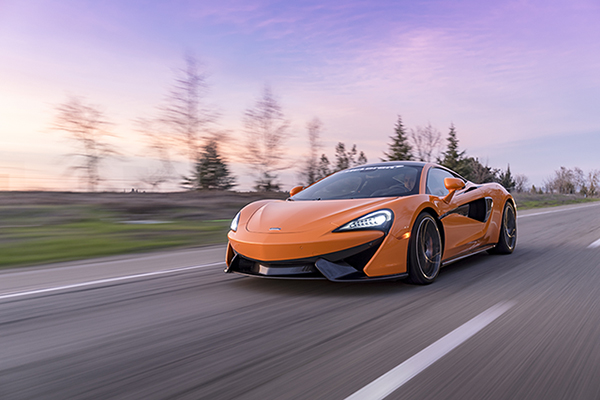
15-30mm (30mm), F/2.8, 1/25th sec., ISO 160
Click image to view larger
After his photo sessions are complete, it's time for Justin to finalize his images. "With inventory photography, I don't touch them up on the computer at all," he says. "We don't want consumers to say, 'That photo was Photoshopped, you guys lied to us about this car.'"
If Justin is prepping an artsier type of photo, however, like for an ad, he'll do some enhancements. "I'll clone-stamp out the reflection of the light across the cars if it doesn't look right, for example," he says. "Or maybe make the rims a shade lighter if the exposure was right on for the body of the car but not for the rims. And for nighttime shots or when I'm light-painting, I'll do what I mentioned before: Take the separate exposures and bring them all together into a final image in Photoshop, like a puzzle. It's a satisfying feeling when I can successfully bring all of those pieces together."
To see more of Justin Keys' work, go to www.justinkeysphotography.com.
More Photo Tips | Watch Videos | Learn More About Tamron Lenses | Photo Gallery
